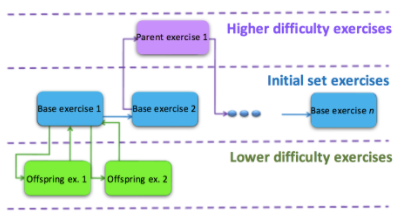By Víctor Francisco Robledo Rella
vrobledo@itesm.mx
Adaptive Learning is a trend in education that has been developed considerably over the past decade. Its main objective is to use the computer power we have today to offer users effective and efficient information that will optimize their learning experience at any given moment. The computer system adapts the delivery of learning resources and the content sequence according to the student’s interaction with the system, their prior performance and the areas of opportunity presented by each student.
By means of diagnostic tests, quizzes and questions about the student’s degree of self-confidence, i.e. how certain the student feels about the responses given when answering quizzes, the system obtains an “academic student profile” for each student regarding her conceptual level and problem-solving skills using data analysis algorithms. In this way, the computer system has the capacity to generate a unique profile for each student, in order to offer her relevant academic content at the appropriate timing. This engages the student and allows her to build self-confidence, creating thus a personalized learning experience.
data-animation-override>
“Adaptive Learning builds a unique learning path for each student.”
If a student masters reasonably well a particular curricular topic, the system allows her to move forward with the next content in order to fulfill the proposed academic goals. On the other hand, if the student shows any deficiency on a specific topic, the “smart tutor” (a software, which uses artificial intelligence techniques; (Cataldi and Lage 2009) provides her with appropriate instructions and exercises in order to take her to the next level of knowledge.
At the same time, the field of Adaptive Learning Analytics uses statistical and data-mining techniques to help the tutor system to determine the best pedagogical actions for each student, employing student metadata, such as: major, semester, average grade, age, learning styles, multiple intelligences, other significant academic indicators, as well as information obtained from the behavioral analysis of a much larger population, according to the student’s level of studies and environment.
Other metadata that can be included in the student profile include biometrics indicators, such as heart rate, perspiration, and even brain activity. This enables the system to define and generate corrective and predictive models with a higher degree of precision in order to assist in taking the best and timely pedagogical courses of action, both for students and professors, achieving thus a more efficient and personalized learning process. Adaptive Learning Analytics and data-mining are front areas in educational research conducted by leading private and academic institutions.
Adaptive learning solution suppliers work on diverse fields of research, including smart-tutoring systems, automated learning, and memory and cognitive load theories (e.g. Edu Trends 2014). Among the current outstanding commercial adaptive learning platforms are McGraw-Hill’s Aleks and LearnSmart, Pearson’s MasteringPhysics, Cengage’s MindTap and WileyPlus’ Orion. In addition, several private firms, such as Knewton, Smart Sparrow, or Desire2Learn (with its LEAP module), serve multiple private publishing houses and academic institutions.
data-animation-override>
“Adaptive Learning Analytics allows better pedagogical actions through corrective and predictive models.”
There are also adaptive learning platforms developed by universities, such as the Tecnológico de Monterrey’s adaptive system Aaprender. This platform uses a conceptual map for specific courses, establishing the modules that comprise it based on a hierarchy:
a. topic
b. subtopic
c. concept
d. item
In the case of the Physics I course, our work group developed exercise sets that contain a series of base exercises, parent exercises (higher level) and offspring exercises (lower level). When students answer a given exercise set, the system takes each student along a different path, depending on the answers being entered. If the student gets a base exercise wrong, the system sends her to an offspring exercise, whose academic objective is for students to understand the missing concept. If the concept is very elaborate, a base exercise may have more than one offspring exercises. When the student answers the offspring exercise correctly, she is sent back to the base exercise. In the same way, if the student answers right the base exercise the first time, the system may send her to a parent exercise that will challenge her comprehension of the concepts related to the base exercise, as illustrated in Figure 1.
The implementation of an adaptive platform implies, besides the computational effort, an important academic effort in building the set of exercises required by the system to “weave” the adaptive paths. It is worth mentioning that our work group has found a significant increment in learning gains through Pre-Test and Post-Test instruments applied to experimental and control groups that have used the Aaprender tool in engineering courses (Neri et al. 2010). At present, we are working on an improved version of the Aaprender system to incorporate it as a tool for the Adaptive Learning Analytics project we are working on.
If you would like further information on the Aaprender adaptive system in order to adapt it to one of your classes, please email me at vrobledo@itesm.mx, or contact one of the platform administrators, Dr. Julieta Noguez Monroy (jnoguez@itesm.mx) or Dr. Luis Neri Vitela (neri@itesm.mx).
I would like to invite all professors to learn more about this topic and to explore the benefits offered by Adaptive Learning. Please feel free to share your teaching experiences with the Observatory of Educational Innovation to enrich other teachers’ tools to foster significant learning by our students.
About the author
Víctor Francisco Robledo Rella is Associate Professor in the Physics and Math Department, and collaborates with the Cyber-Learning Lab & Data Science research group of the Tecnológico de Monterrey, Campus Ciudad de México.
This article from Observatory of the Institute for the Future of Education may be shared under the terms of the license CC BY-NC-SA 4.0 
)
)



)